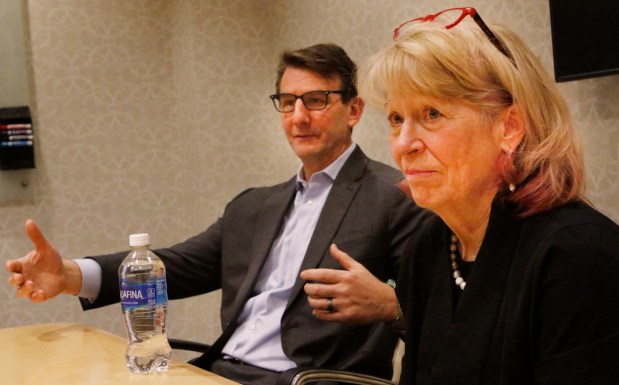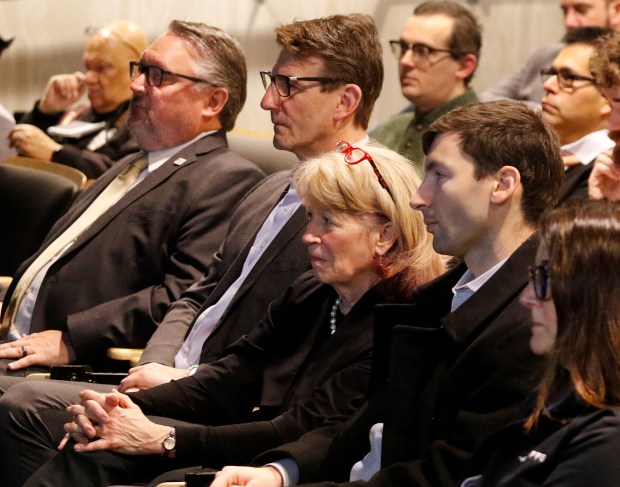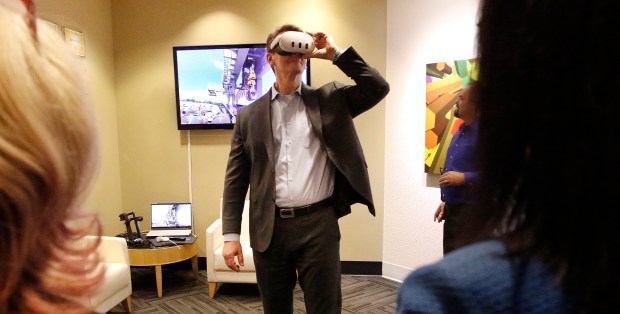Federal and local officials got a close look Friday at some of the cutting-edge research in Northwest Indiana that is attempting to decarbonize the steel industry and boost efficiency.
U.S. Rep. Frank Mrvan, D-Highland, and U.S. Department of Energy Under Secretary for Science and Innovation Geri Richmond lauded the work done by Purdue University Northwest’s Center for Innovation through Visualization and Simulation (CIVS) in Hammond.
In January, the DOE announced a grant of over $7.1 million to support CIVS. Founded in 2009, the center employs simulation and modeling software to create virtual versions of industrial sites, fostering a deeper understanding of how to make those facilities safer and more efficient. The announcement came on the heels of another DOE grant — the center was awarded just under $10 million from the department’s Industrial Efficiency and Decarbonization Office in October.
Professor of Engineering Simulation Chenn Zhou, who serves as the center’s director, showed Mrvan and Richmond a three-dimensional model of a U.S. Steel blast furnace that allows researchers to measure temperatures, concentrations of different gasses, and other variables at different points within the furnace. The model, created using data from its real-world counterpart at the company’s Gary Works facility, allows staff at the center to gather information that in many cases would be impossible to measure on-site; the blast furnace, which can reach temperatures in the thousands of degrees, would destroy any measuring devices deployed inside it.
Improving the efficiency of steelmaking facilities means fewer fossil fuels burned and fewer pollutants emitted, Senior Research Engineer Kyle Toth said. The center has also partnered with steel giant Cleveland-Cliffs, which in January conducted a successful trial of hydrogen injection technology at its Indiana Harbor facility in East Chicago. It was the company’s second trial of the technique, which involves replacing some of the fossil fuels burned in a blast furnace with clean-burning hydrogen gas.
Computer modeling allows Toth and his colleagues to measure how injected fuels influence the behavior of gasses within the furnace, generating data that Cleveland-Cliffs can use to minimize waste and improve the furnace’s efficiency.

“There’s a lot of conditions that we’re trying to study and understand here,” he said.
The center uses an array of different software for its simulations, including some programs like the Unity and Unreal engines that were developed for the video game industry. The center’s three-dimensional virtual environments are also used for job training, allowing industry technicians in training to virtually experience an array of scenarios and learn how to respond properly. Trainees don virtual reality goggles and navigate a digital analog of a real industrial site, a safer and more time-efficient alternative to on-site exercises.
PNW chancellor Chris Holford said that the center’s work dovetails with other efforts by the university to produce capable and qualified workers for local companies.

“Our goal is to be training not only today’s workforce but the future workforce 10 years out, because as we transition to more and more hydrogen combustion at an industrial scale, you’ll also see the innovation and commercialization at a smaller scale,” he said. “So industrial decarbonization and hydrogen consumption will fuel technological advancement which will eventually translate into the automotive industry and other industries around us and a lot of that work will be going on right here in Northwest Indiana.”
Richmond said that PNW and other region institutions “shone like a beacon” during the competitive application process for federal “hydrogen hub” funding. In October, a regional partnership spanning Illinois, Indiana and Michigan with dozens of private and public partners was announced as a recipient of up to $1 billion in DOE funds. CIVS, Richmond said, will help partners in the hub develop more efficacious and useful hydrogen partners.
“If you don’t do things like they’re doing here with students, to be able to start to simulate what might happen under different conditions,” she said, “you have to go to the lab and keep trying them over and over and over again.”

Mrvan and Richmond toured Cleveland-Cliffs’ Indiana Harbor facility after the stop in Hammond.



